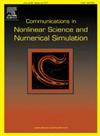具有干摩擦耗能的声黑洞束结构:概念建模、求解方法及效果分析
IF 3.8
2区 数学
Q1 MATHEMATICS, APPLIED
Communications in Nonlinear Science and Numerical Simulation
Pub Date : 2025-09-26
DOI:10.1016/j.cnsns.2025.109374
引用次数: 0
摘要
声黑洞(ABH)光束可以通过其几何结构收集振动能量。因此,它在能量收集和振动抑制方面具有很大的应用潜力。通常在ABH结构上引入阻尼层来衰减振动能量。然而,阻尼层的厚度会影响能量收集和减振效果。因此,本文采用摩擦阻尼组件代替阻尼层来耗散聚集的能量,提出了一种干摩擦阻尼ABH梁结构。采用假设模态法建立了ABH梁结构的动力模型。采用LuGre模型对摩擦元件的受力进行表征。采用提出的时频有限差分谐波平衡法求解系统的动力响应。验证了干摩擦阻尼ABH梁结构的减振效果和优越性。分析了影响减振效果的参数。结果表明,本文提出的干摩擦阻尼减振结构能比阻尼层更有效地衰减振动幅值。在一定预紧力范围内,越高的摩擦系数越有利于减振。本文提出的减振方法在各种幂律下都能取得良好的减振效果,说明该方法在不优化ABH形状的情况下也能有效地衰减振动幅值。本文章由计算机程序翻译,如有差异,请以英文原文为准。
Acoustic black hole beam structure with dry friction energy dissipation: Conceptual modeling, solution method, and analysis of effect
The acoustic black hole(ABH) beam can collect vibrational energy through its geometric structure. Therefore, it has great potential for application in energy collection and vibration suppression. Damping layers are usually introduced on ABH structures to attenuate vibration energy. However, the thickness of the damping layer may affect the energy harvesting and vibration attenuation effect. Therefore, this paper used friction damper components instead of damping layers to dissipate gathered energy and proposed a dry friction-damping ABH beam structure. Established a dynamic model of the ABH beam structure by using the assumed modal method. Using the LuGre model to characterize the force of friction elements. The dynamic response was solved by using the proposed finite difference time-frequency domain harmonic balance method. Then, the reduction effectiveness and superiority of the dry friction damping ABH beam structure were verified. The parameters affecting the vibration reduction effect were analyzed. The results indicate that the dry friction damping vibration reduction structure proposed in this paper can attenuate vibration amplitudes more effectively than the damping layer. A higher friction coefficient is more favorable for vibration attenuation within a certain range of preload. The vibration reduction method proposed in this article can achieve good vibration attenuation effects under various power laws, indicating that this method can also effectively attenuate vibration amplitude without optimizing the ABH shape.
求助全文
通过发布文献求助,成功后即可免费获取论文全文。
去求助
来源期刊

Communications in Nonlinear Science and Numerical Simulation
MATHEMATICS, APPLIED-MATHEMATICS, INTERDISCIPLINARY APPLICATIONS
CiteScore
6.80
自引率
7.70%
发文量
378
审稿时长
78 days
期刊介绍:
The journal publishes original research findings on experimental observation, mathematical modeling, theoretical analysis and numerical simulation, for more accurate description, better prediction or novel application, of nonlinear phenomena in science and engineering. It offers a venue for researchers to make rapid exchange of ideas and techniques in nonlinear science and complexity.
The submission of manuscripts with cross-disciplinary approaches in nonlinear science and complexity is particularly encouraged.
Topics of interest:
Nonlinear differential or delay equations, Lie group analysis and asymptotic methods, Discontinuous systems, Fractals, Fractional calculus and dynamics, Nonlinear effects in quantum mechanics, Nonlinear stochastic processes, Experimental nonlinear science, Time-series and signal analysis, Computational methods and simulations in nonlinear science and engineering, Control of dynamical systems, Synchronization, Lyapunov analysis, High-dimensional chaos and turbulence, Chaos in Hamiltonian systems, Integrable systems and solitons, Collective behavior in many-body systems, Biological physics and networks, Nonlinear mechanical systems, Complex systems and complexity.
No length limitation for contributions is set, but only concisely written manuscripts are published. Brief papers are published on the basis of Rapid Communications. Discussions of previously published papers are welcome.
 求助内容:
求助内容: 应助结果提醒方式:
应助结果提醒方式:


